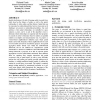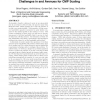1052 search results - page 101 / 211 » Understanding POWER multiprocessors |
ALMOB
2006
13 years 9 months ago
2006
Background: Bifurcation analysis has proven to be a powerful method for understanding the qualitative behavior of gene regulatory networks. In addition to the more traditional for...
KDD
2009
ACM
14 years 9 months ago
2009
ACM
Spatial classification is the task of learning models to predict class labels based on the features of entities as well as the spatial relationships to other entities and their fe...
ISPASS
2010
IEEE
14 years 3 months ago
2010
IEEE
—The ongoing move to chip multiprocessors (CMPs) permits greater sharing of last-level cache by processor cores but this sharing aggravates the cache contention problem, potentia...
SASP
2009
IEEE
14 years 3 months ago
2009
IEEE
— As growing power dissipation and thermal effects disrupted the rising clock frequency trend and threatened to annul Moore’s law, the computing industry has switched its route...
ISCA
2009
IEEE
14 years 3 months ago
2009
IEEE
As transistor density continues to grow at an exponential rate in accordance to Moore’s law, the goal for many Chip Multi-Processor (CMP) systems is to scale the number of on-ch...


